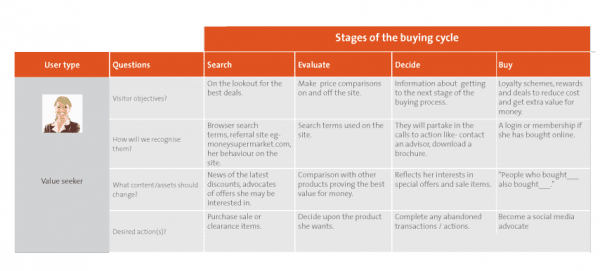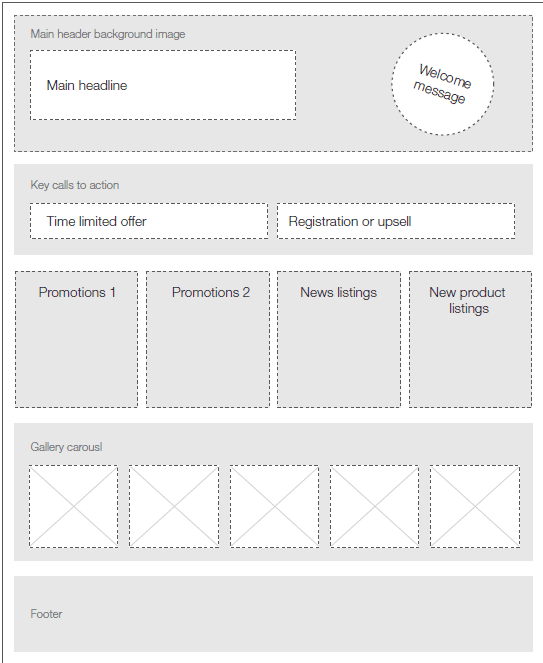Match personas, content changes and stages of the buying cycle to help you nurture your leads
In my last post, Personalisation 101- How to increase customer engagement and conversion rates, I introduced the main types of personalisation available to make your site more customer-focused. In this post I'll expand on this by recommending approaches to segmenting your audience and making sure that your website’s personalisation directly meets your overall business objectives. I will show how to:
- Use business objectives to define measurable actions
- Identify the weaknesses in your website
- Create personas for your core audience types
- Use a Digital Relevancy Map to plot specific actions to personas and buying stages
- Create a wireframe to translate this knowledge onto your webpages
- Test and measure personalisation.
Making actions meet your business objectives
The first step is to lay the foundations for personalisation. To make a business case for personalisation you need a clear map of what personalisation and customer engagement means directly for your business. Here are a couple of resources that expand on this:
Both will help you to align strategies and marry customer and business satisfaction.
Every element of digital engagement has to lead to company or campaign objectives. This stops the manufacturing of goals which do not bring measurable benefits to the business.
When you focus on marketing goals which meet your business objectives, the result is that calls to action are clearer which will promote the agreed objectives.
Tools for a reality check
There are some important questions you need to ask about your website which will help you pinpoint its weaknesses. Here are some which will help you do this:
- What are the least popular pages?
- Where do people tend to ‘bounce’ and leave the website?
- When do people abandon their transaction?
- What are the most common search terms in search engines that bring up your website in search results?
- If a visitor searches your website what are the most common search phrases?
You can find the answers to these questions using tools that give insight into how your website is performing so that you can assess its strengths and weaknesses: • Google Analytics • SEOMoz • AnalyticsSEO • Smart Insight’s Digital Marketing Health Check. These are the essential tools that will help you find and fix the weaknesses in your website and your marketing strategy.
Personas
Defining personas is a powerful approach to help deliver specific content and messages to your key user types. Dave Chaffey explains more in his post on personas for web design. The different types of personalisation I went through in the last blog post offer a nuanced and reactive website experience. Before we get to that we have to ask some fundamental questions about our customers:
- What are the key characteristics of each type of customer?
- What motivates them to come to you?
- What is your response to each persona?
- What does that response prompt them to do?.
Learning about what your customers do and do not want is arguably easier if you are a B2B Marketer. This is because the companies you are catering for can be researched as they are likely to have an online persona much like any business. They will probably be more forthcoming when it comes to telling you what they think of your website and what they use it for if they know that this information will go into improving it. Your customer, no matter who they are, will always surprise you but by doing this initial groundwork you will be adapting and enhancing your content based on who your customer is and not who you think they are. Going back to basics can often bring up new and exciting business avenues and ideas, and possibly a new customer base that you had not recognised.
Digital Relevancy Map
Once this foundation research is done, I suggest you create a Digital Relevancy Map, once again leaving the idealism at home.
The Digital Relevancy Map aligns the personas you have created with your business objectives.
Examples of Personas
- Which persona will be most interested in cut price basics? This will help you meet the business objective of clearing old stock from your warehouses.
- Which persona are your early adopters? Show them the cutting edge of your business.
Here is an example of a Digital Relevancy Map which matches personas, content changes and stages of the buying cycle to help you nurture your leads:

As you can see every bit of content is being tailored to their persona and where they are in the buying cycle. Having business objectives at the forefront will only serve to make your content and calls to action clearer and therefore more effective. These objectives keep everyone in your organisation on message and on target!
My last blog post covered how these personas are identified, Personalisation 101- How to increase customer engagement and conversion rates. Once you have identified your customers you can give them content which is relevant.
The Digital Relevancy Map must not be limited to one path, the customer may change and wander off course, clear signposting and site navigation will make them feel secure and keep them from veering off course.
These maps not only help with the communication between customer and business, they help communication within the business, so that every team knows their role within the customer journey. We have now built a foundation for personalisation by integrating customers’ goals and your business’ objectives in a Digital Relevancy Map.
Wireframes
All this information allows us to move onto the second stage which puts the personas and content you have identified together.
Here we target content onto the wireframes for each persona and for each stage of the buying cycle. Involve people across your whole business and use their skills and knowledge of the business and its customers to inform the wireframe content.
If you would like to see some exemplary landing pages in order to get some inspiration for how to structure your information, including clear calls to action, Smart Insights offer a detailed description of the Ideal Landing Page. Below is a picture of a bare wireframe that shows you the templates and widgets which can change depending on the persona of your visitor.

Truth and Consequence
This is the point where you learn exactly how easy your website is to use and whether the calls to action on the website are leading to conversions. The tools you used for identifying your website’s weaknesses can still be used to monitor and optimise your new website. Setting up value based analytics will help you keep track of the good and the bad results your website may be getting.
The online tools can all be used to run reports so that you can see how changes to the website affect the customer conversion rates over time.
As I have said before your customers will surprise you. Even once your new personalised website is on its way adjustments will have to be made. Personalisation is an engagement with your customers and in successful engagement being attentive to their changing needs is really important. There are Content Management Systems that “learn” and adjust as required. It is a good idea to review your website on a weekly basis for the first few weeks. Then you can be sure that the calls to action are working as well as possible and that business goals are being achieved by the right groups of users.
Takeaways on personalisation
- The foundations of making personalisation work for your business
- How the personalisation of your website will match your customers’ goals to your business objectives
- You should now be on your way to getting some tools which will help you identify the weaknesses on your website and identifying exactly which pages are not bringing anything to your customers or your business
- Once you have aligned the personas and business objectives you are ready to translate this into the wireframes for your website
- Testing and measuring is, as every marketer knows, vital. Little and often will ensure that the personalisation of your website brings you the business success you seek.
My next blog post will be an in depth look at Digital Body Language- using your visitor’s behaviour on your website to increase engagement and conversion.
Useful Links

Nina Anderson is a Sales and Marketing Executive specialising in digital marketing. She works at
ClerksWell in London providing digital solutions and website design and build. They are a Sitecore partner and pride themselves in delivering their Customer Engagement Platform with enhanced design and usability. Thanks to Nina for sharing her advice and opinions in this post. You can follow her on
Twitter or connect on
LinkedIn.





 Nina Anderson is a Sales and Marketing Executive specialising in digital marketing. She works at
Nina Anderson is a Sales and Marketing Executive specialising in digital marketing. She works at 



